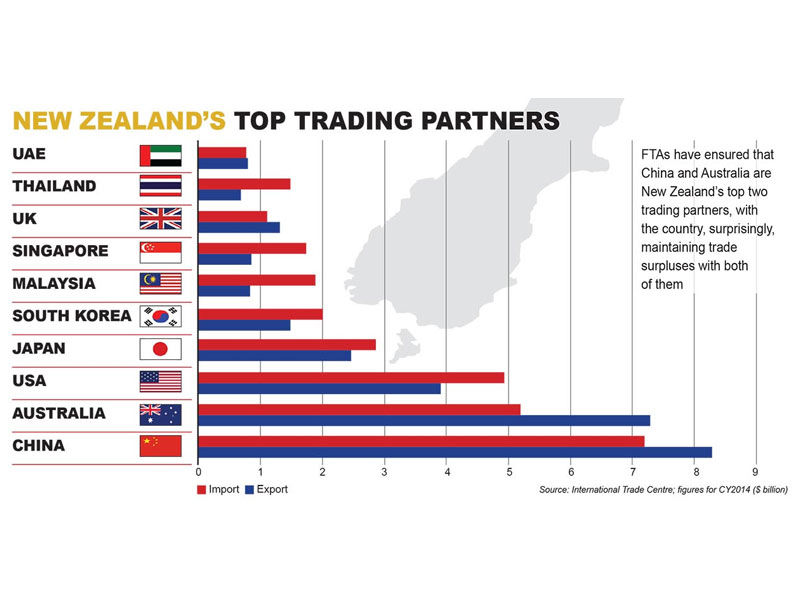Although New Zealand‘s economy is developed, it is still relatively tiny in comparison to other countries. Based on the export of agricultural goods, New Zealand‘s quality of living was among the greatest in the world in the late 19th and early 20th centuries, but from the mid-20th century, the pace of increase tended to be among the lowest among industrialized nations. Economic development has been hampered by the United Kingdom’s economy’s sluggish expansion (which was once New Zealand’s top export market) and its eventual accession to the European Union.
Trade
New Zealand’s main exports are agricultural goods, including meat, dairy products, fruits, and vegetables. Crude oil, wood products, and paper products are also significant. Crude and refined oil, equipment, and automobiles are the main imports. China, Australia, the United States, Japan, Germany, and South Korea are New Zealand’s top trading partners.

The Closer Economic Relations Trade Agreement (also known as CER), signed in 1983 between Australia and New Zealand, was built on several previous trade accords. Some people viewed that agreement as the first step towards the integration of their economies since it finally reduced levies and commodities quotas between the two nations. Australia, New Zealand, and China all have free trade agreements with the Association of Southeast Asian Nations (ASEAN), while New Zealand also has a free trade deal with China.
New Zealand recession
After the country’s central bank aggressively increased interest rates to a 14-year high, the economy of New Zealand entered a recession.
According to official data, its gross domestic product (GDP) decreased by 0.1% in the first three months of the year. The economy is now in a “technical recession” as a result of it, which came after a 0.7% decline in the previous quarter.

Since October 2021, the Reserve Bank of New Zealand (RBNZ) has dramatically increased borrowing costs.
Following the epidemic, New Zealand was among the first nations to begin hiking interest rates, and it has done so faster than the US Federal Reserve. The RBNZ raised its benchmark interest rate to 5.5% last month.

With prices already on the rise, New Zealanders are now suffering the effects of increased rates as their mortgage payments and other borrowing costs rise.
To contain price increases brought on by economies opening up following the Covid lockdowns, central banks all over the world raised borrowing costs.
The Ukraine war’s increased cost of everything, including food and petrol, contributed to inflation as well.
In the first three months of this year, teachers’ strikes, Cyclones Hale and Gabrielle, and other events all affected New Zealand’s economy.

The government projects that cleaning up the damage brought on by the harsh weather will cost up to NZ$15 million (US$9 million).
Since the pandemic locked down borders and stifled exports in 2020, New Zealand has not had a recession until now.
The center-right opposition was quick to criticize the government for the economy’s contraction, inflation’s increase to 6.7 percent, and the impending election on October 14.

In contrast, households reduced their purchases of products, notably food, even while the price of those items continued to rise. Grocery food costs increased 12.7% over the same period last year, with fruit and vegetable prices up 18.4%, according to price index data issued on Wednesday.
Also read: El Niño and its Impact on the World Economy
The rate of economic shrinkage has exceeded what the Reserve Bank of New Zealand had predicted earlier in the year. The bank had predicted that the GDP would rise by 0.3% in the March quarter and then moderately decline in the next three months. As it regularly hiked the official cash rate to curb inflation, the bank had previously stated that it aimed to arrange a “soft landing” during the recession.

























